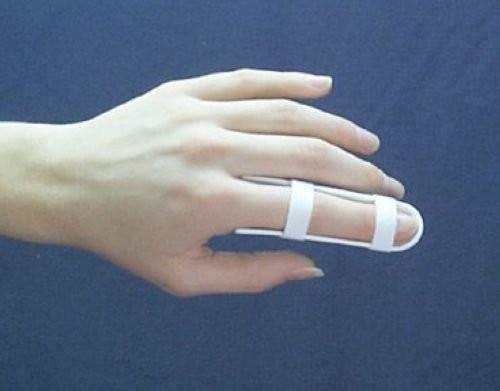|
BOOK NOW |
ASK ABOUT YOUR PAIN |
Home > Blog > Hand Therapy & Customized Splinting > Finger, Hand, Wrist, Forearm & Elbow Conditions > Finger Dislocation Hand Therapy
Finger Dislocation Hand Therapy

A finger dislocation refers to an injury to the joint of the the finger bones where the joint separates and bones moved apart, malaligned. Most of the time, dislocation in finger joints happen when the finger is over-bent backwards or sidewards beyond the normal maximum range of motion.
Medical terms:
- finger bones are known as phalanx for singular, and phalanges for plural
- hand bones just before the finger bones are the metacarpals
Our hands and fingers are very nimble and flexible because of multiple small bones and joints for every single finger...and unfortunately also, every joint can be injured and dislocated with force.
- Distal inter-phalangeal
joints
(DIPJ) are the joints in the fingers that is closest to the fingernails. Most
dislocations in these distal finger joints are caused by direct trauma, and sometimes accompanied with an open
wound in the location of the dislocation.
- Proximal inter-phalangeal joints (PIPJ) are the middle joints of the finger joints. These dislocations are often called jammed finger or coach's finger. It is the most common hand injury in athletes, especially among those who play ball-handling sports, such as football, netball, basketball and water polo. Usually, these types of dislocation happens because the fingers are bent backward/sidewards when an athlete tries to catch a ball or block a shot. These interphalangeal joint dislocations also can happen when an athlete's fingers are hooked awkwardly such as caught in opponent's shirt, in game such as rugby, twisted or bent by an opponent, especially when two athletes wrestle or grab for control of a ball.
- Metacarpo-phalangeal joints (MCPJ) are the knuckle joints, located where the palm joins to the fingers. These joints are fairly strong and stable, hence metacarpophalangeal joint dislocations are less common than the other two types. When metacarpophalangeal dislocations do occur, they are usually dislocations of either the index finger or little finger.
Symptoms of Finger Dislocation

When a patient dislocates his or her finger, it's often:
- crooked
- swollen
- painful
- there may be open wounds such as scrapes, lacerations, cuts
If the dislocation happened during a game on-field and "fixed" on the spot, the patient may feel that their finger is:
- loose/unstable (early part of recovery)
- weak/no power
- stiffness/tightness (later part of recovery)
If left untreated or to heal "naturally" without intervention, patients usually end up with a very stiff finger with difficulty using as usual (difficulty bending and straigthening) - this is due to the scar tissues inside that needs to be managed by a hand therapist.
finger dislocation Diagnosis
Your doctor will suspect that your finger is dislocated if it appears swollen and deformed.
In some cases, your doctor may order an X-ray of your finger if he or she suspects that there is also fractures together with the dislocation. What happens when there is a combination of BOTH fracture and dislocation, the finger bone can end up being pulled away from connected tendons.
This is a is common occurrence for a fragment of bone to separate from the main bone and stay with the tendon, a condition known as an avulsion fracture.
Expected recovery Duration

Usually, you can return to work, life, responsibilities and sport once your dislocated finger has been realigned and stable, and following a confirmation from your doctor that the injured joint is stable with no presence of bone fracture, and your finger tenderness and swelling have improved.
For a few weeks, you will need to wear a customized finger splint or buddy tape, which is used to protect, support and strap the injured finger.
If your finger dislocation is severe and you end up requiring to repair your dislocated finger, it'd conservatively take a good 6-12 weeks for soft tissue (such as ligaments) to heal and strengthen before you can return to normal movement and a little longer for sports. Post injury/operatively, you'd need to start hand therapy to manage and prevent finger stiffness, which will be your #1 challenge to get back full range of motion and function in your finger.
Prevention
Once we have resolved and treated your finger dislocation, there are some preventative things you can do to prevent your finger from future dislocation. You can:
- continue using the finger splint
- use a buddy splint or buddy tape
- continue strengthening your hands and fingers
Speak to our senior hand therapists to see which preventative options are best suited for you.
Treatment
A simple dislocated finger can be corrected with or without injecting local anesthesia (sometimes adrenaline is enough that you may not feel pain or realize it).
To correct the dislocation, the doctor will press against the displaced bone to loosen and dislodge the bone if it is an awkward position eg side of the joint. Once the end of the bone is freed, the doctor will pull outward and release the bone to restore the bone to its correct position (termed as closed reduction).
Once your finger joint is back in its normal position, you
will wear a splint or tape the finger to another finger for three to six weeks,
depending on the specific type of your dislocation, then commence on hand therapy after weeks 4-6, once the doctor has determined that your injury is stabilized.
However, what happens if the
doctor cannot straighten your finger using closed reduction or if you and the doctor realize that your injured
joint is not stable after closed reduction, then your dislocated finger may need to
be repaired surgically.
When Should You Call a Professional?
You should call your doctor immediately if you had injured your finger and you find that your finger is
- crooked
- deformed
- painful or
- swollen
You can also contact us if you have the symptoms above, but feel that you don't have a fracture - our senior hand therapist can assess and treat you first, or if we find that you need a hand surgeon or orthopedic surgeon, we can refer you direct as well.
If you are an athlete when you experienced the finger dislocation, and you had someone straighten/relocate your injured finger on the field, please check with your doctor or your on-site physiotherapist to make sure that the injured joint is stable and with no fractures.
A dislocated joint that has an open wound should not be moved at all. It should be carefully splinted and evaluated immediately by a physician.
Hand Therapy for Finger Dislocation

Your biggest challenge following a finger dislocation is decreased range of motion and ongoing battle with stiffness. If left unmanaged and to "heal naturally", you may end up with a very stiff finger with decreased movement, decreased function and decreased strength.
Regular and early hand therapy, which will include
- heat therapy to soften stiff structures
- exercise therapy to strengthen weakened muscles
- scar management to decrease scarring
- customized splinting to keep the injured joint
aligned,
and ultimately restore your joint to full movement and function. The earlier you come for hand therapy, the better the outcome, movement and function-wise.